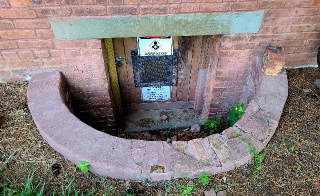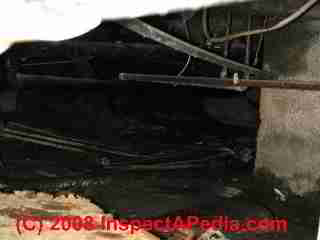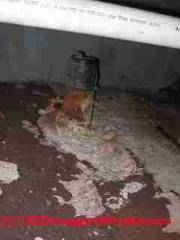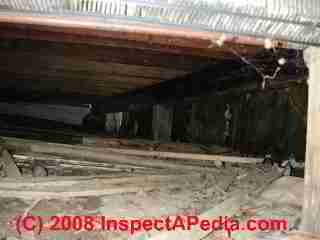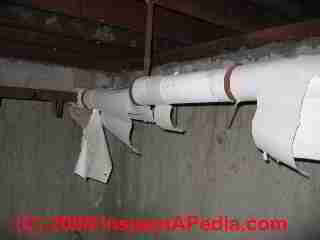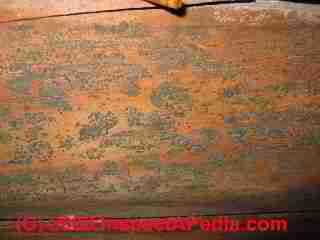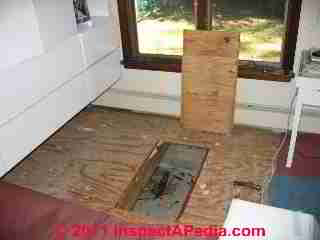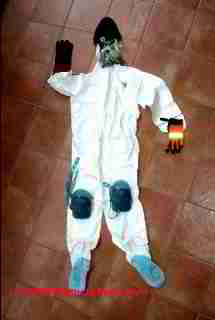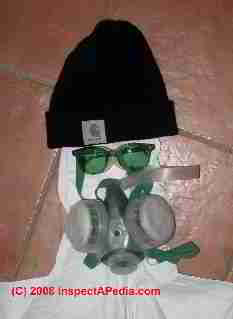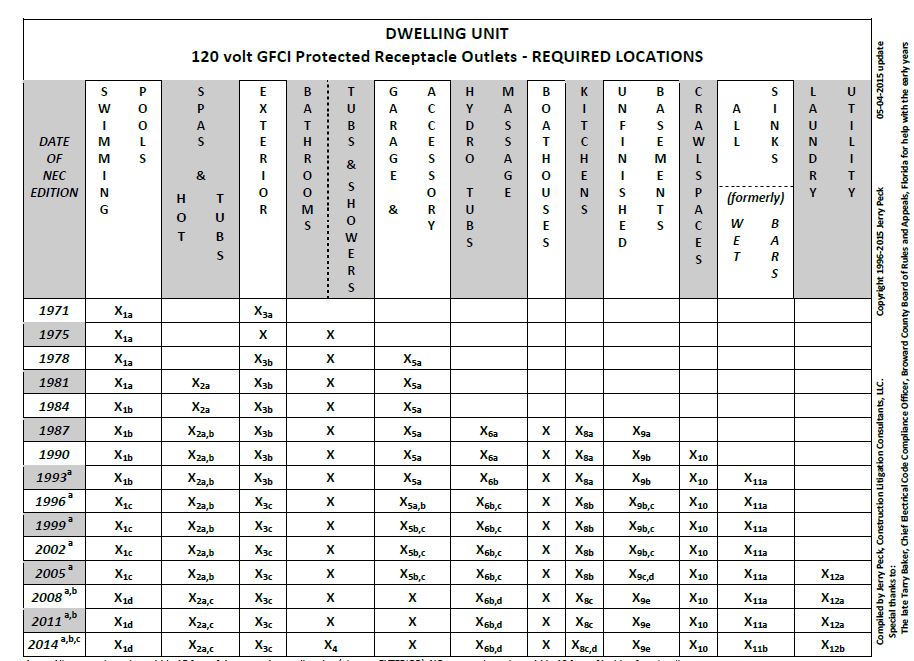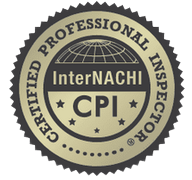731-217-4173
Crawl Space Safety
This article lists potentially dangerous or unhealthy conditions that should be evaluated by an inspector or worker who is expected to enter, inspect, or work in a crawl space anywhere in a building.
The crawl space is shown in our page top photo, located on the Vassar College campus (Poughkeepsie NY) is locked and carries two CRAWL SPACE WARNING LABELS warning of asbestos hazard, protective gear required, and thus, crawl space access restrictions.
At a property inspection, the decision to enter or not a crawl space or any other area that the inspector may believe is unsafe or inaccessible is made by the inspector on the scene, not by anyone else.
Crawl Space Safety for Home Inspectors
Is the crawl space safely accessible, or accessible at all?
A number of conditions besides the old saw “accessibility” or size of the crawl space opening should be considered carefully by the home inspector, electrical inspector, or anyone who is deciding if it is safe to enter a crawl area anywhere in a building.
Separately at CRAWL SPACE ACCESS we describe codes & standards for accessing building crawl spaces and we describe methods used to enter or inspect crawl areas that are not accessible by normal means of an available hatch or opening or that lack adequate safe space for entry.
- Is there standing water in the crawl area?
If the crawl space has areas of puddles or standing water or even if the soil surface is simply wet there is risk of electrical shock (if wiring or electrical devices are present).
There may also be a chemical contamination risk, especially in older buildings where pesticides may have been applied in the crawl area.
- Are there or were there previously wet areas in the crawl space?
Is there evidence of previous wetting or burst sewer piping or sewage backups or spills?
- Watch out for sewage backups & spills in the crawl area. Entering sewage-contaminated areas, even if currently dry, is unsafe unless you are wearing proper protective gear.
Hazards include both wet sewage pathogens and even airborne or dust-borne dry pathogens.Our photo (left) illustrates a crawl area that is hazardous: we see toilet paper around an abandoned sewer line access or cleanout (now capped off) and we see a newer PVC waste line overhead. Consider the sewage pathogen risks to workers who capped the old waste line and installed the new one.
The sewage-contaminated soil surface debris should have been removed, the area sanitized, and it may have made sense to install new clean plastic ground cover in this area.
- Is there excessive debris in the crawl area? Nails, splinters, and possibly rodents may be in the debris in our photo at left.
- Are there wet crawl area floors or other surfaces? Crawling exposes a lot of body surface to the ground or other surfaces and limits movement. There maybe shock hazards or chemical hazards even if there is not actual standing water.
Beware also of evidence of structural collapse when looking at a flooded or very wet crawl space. Piers are undermined, foundations may be collapsing.
- Are there chemical odors in the crawl space?
If so there is an increased risk of chemical contaminants that could be hazardous. You should not enter such an area without proper protective clothing, respirator, etc.
- Is there evidence of asbestos insulation, especially disturbed,damaged, or deteriorated asbestos insulation?
Do not enter such an area without protective equipment; take care that you do not track hazardous materials out of the crawlspace and into other building areas.
Often we find a crawl area in which the asbestos pipe insulation is not just hanging (photo at left) but has fallen onto the crawl space floor.
- Is there evidence of mold contamination such as areas of wood, paper, or other material covered with mold or mold-suspect material. Do not enter such an area
without the required PROTCTIVE GEAR for ENTERING CRAWL SPACES
Watch out: for crawl space mold hazards we provide separate warning information
Do not enter such an area without protective gear and appropriate training.
- Is there evidence of rodents or snakes or insect pests in the crawl space? Rodent hazards include bacterial and viral and respiratory illness; there is the obvious risk of snake bites in a confined space, and more than once we’ve been run out of a crawl space by bees or hornets.
But since you’re unlikely to be able to move rapidly to make an emergency retreat from threatening pests, crawl areas are riskier than some other building areas.
Evidence of pests may also suggest risk of improperly applied and unsafe exposure to pesticides.
- Is there sufficient space for safe access to enter and move safely in the crawl area. Review the OSHA regulations on entering confined spaces. The inspector or worker should decide if s/he a building area is safely accessible.
Do not enter a confined space if you are working alone at a property. If circumstances mean you cannot avoid such an entry, be sure you carry:
- A working cell phone that will function in the space
- A spare flashlight
- Appropriate protective gear
- A camera to use for documenting conditions – it’s easier than dragging along clipboards and pens.
- Is there wet or falling or rodent-infested fiberglass insulation in the crawl area? If so there is a high risk of mold or rodent contaminants that could present a fungal, bacterial, or viral airborne hazard.
Do not enter such an area without proper protective gear.
- Is there evidence of risk of structural collapse or even structural movement in or over the crawl area?
Look closely at columns, posts, piers, girders, joists, and perimeter foundations.
It is easy to become pinned or even crushed if you enter an unstable structure.
Examples of Crawl Space Safety Gear for Entering Crawl Spaces & Mold Contaminated Areas
These crawl space safety suggestions are not an exhaustive inventory of all safety procedures nor gear should be used when entering a crawl space. Additional protective equipment and even accompaniment, breathing apparatus, and rescue gear may be required according to building structure, safety, and other conditions.
- Assistant or accomplice: do not enter an unsafe or confined space alone – station an assistant at the entry and maintain contact.
- Battery operated flashlight and spare flashlight. A spare light is important if the crawl area is large and you could be far from the entry – to avoid being trapped in darkness if your first light fails.
Watch out: Dragging an extension cord and trouble light into a crawl area, powered by plugging the extension cord into a wall receptacle is dangerous unless the cord is protected by GFCI and AFCI devices.
- Cell phone or two-way radio – to summon help in an emergency
- Eye protection – in dusty areas full-coverage eye protection or goggles are most secure; in low-dust areas, eye protection such as the safety glasses in our photo below have the advantage of less tendency to fog up in humid work areas.
- Gloves – to protect hands especially if you need to crawl. The very thick welder’s glove on our mock-up photo’s right-hand offers good dry-area protection but makes it almost impossible to handle a camera or other equipment. For wet areas, we wear heavy rubber padded gloves.
- Knee pads – we like the gel-type knee pads shown in our mock-up photo – they make crawling easy on the knees, and their thickness keeps the legs and knees up off of damp surfaces.
- Protective clothing – jump suit, tyvek suit (shown in our photo), padded clothing
- Respirator, with cartridges rated for both organic chemicals and fine particulates – a HEPA filter and charcoal filter or other special filters may be required. Do not rely on a simple paper dust mask.
- Head protection – depending on space this may be a hard hat or if that is impractical because of limited space, a soft padded hat may be useful.
Watch out: for protruding nails or other sharp objects that can poke right through a soft hat like the one we show at left.
Your Trusted Home Inspector
My name is John de Saint Georges and I own The Inspection Company LLC. I have been living in West Virginia for the last 10 years and have loved every minute of it. From the New and Greenbrier rivers and Snowshoe Mountain, this state has it all. I hope I can help you look over your new home here in the mountain state. I will let you know everything that you may need to know about your new home
Whether it’s a 1000-square-foot loft, a rambling country estate, or 6000-square-foot commercial building, I won’t rest until you’ve received my easy-to-read report and all of your questions have been answered.
The Inspection Company uses the latest home inspection software to deliver you a visual, modern home inspection report that explains our findings in a way you can understand.

